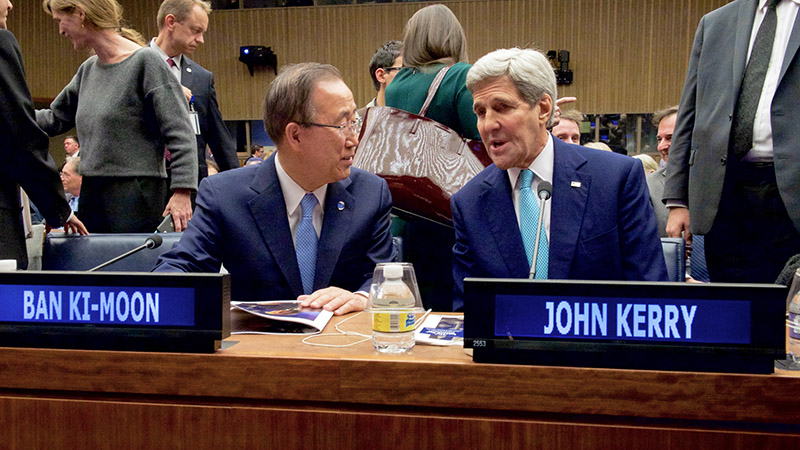Athena Ballesteros, Philippines climate negotiator, head of Asia Climate Finance strategy at Growled Family Fund
China taking on leadership in greening its finance sector with major policy recommendations feeding into the Mark Carney and Bloomberg Task Force on Disclosure but also straight to the G20 leaders communique. As the largest bilateral source of financing for energy and infrastructure investments (US$250 billion) China committing to “green” its finance and investments makes a huge difference and sends strong political signals.
Michael Zammit Cutajar, former UN climate chief
My highlight was the Paris Agreement entering into force, amid reports of growing competitiveness of renewable energy technologies versus coal.
Teresa Ribera, director of Paris-based think tank IDDRI
It was a stormy year. My highlights are the announcement that countries agreed to place the Ross Sea (a large bay of the Southern Ocean in Antarctica) under protection, we saw Arctic temperatures 20C higher than usual; the Paris Agreement came into force in record time for a major UN deal; and finally we now have the prospect of climate denier heading the US Environmental Protection Agency.
Richard Betts, Met Office Fellow, Head of Climate Impacts Research
My highlight of 2016 was successfully forecasting the CO2 concentrations at Mauna Loa (home of the iconic Keeling Curve) for the year, including the fact that this would be the first year with CO2 above 400ppm all year round, due to the influence of the EL Nino giving the CO2 rise an extra kick on top of the effect of human emissions
We predicted that the CO2 concentration in May would be 407.57 +- 0.53 ppm, and the actual value was 407.70 ppm so we were astonishingly spot-on (must have been a bit of luck involved there I think!). But more importantly, we predicted ahead of time that 2016 would be the first year in which the CO2 stayed above 400ppm all year round.
We forecast the minimum in September to be 401.48 +-0.53 ppm, and the actual value was 401.03 ppm. The key point is that this would not have been expected just by extrapolating the trend from previous years – it was the fact that we could forecast the El Nino and then translate this into an additional CO2 rise on top of human emissions that was important.
Liz Gallagher, senior policy advisor, E3G
For me 2016 was the year in which the momentum from the Paris Agreement jump started. The Kyoto Protocol took 7 years to enter into the full force of international law, whilst Paris Agreement took just 11 months, demonstrating the sincerity of countries commitment to the agreement.
This was boosted by countries collectively agreeing to phase down the potent greenhouse gas – HFC – the result being the equivalent of taking 500 million cars off the road.
Isaac Valero-Ladron, member of EU Climate Action and Energy Commissioner cabinet
EU ratification of the Paris climate deal and the entry into force of the Agreement.
Nick Molho, executive director, Aldersgate Group
Despite a challenging political context, there has been some important progress on the climate agenda in 2016 with the ratification of the Paris climate agreement, an agreement to phase out damaging HFC gases, the first agreement to start tackling global aviation emissions and the global low carbon economy continuing to go from strength to strength.
In the UK, despite a change of government and a departmental restructuring, the government adopted the fifth carbon budget and some positive developments took place in the UK low carbon supply chain such as with the official opening of the Siemens offshore wind factory in Hull and the announcement by CS Wind to manufacture offshore wind towers in Scotland.
Nick Nuttall, head of communications, UN climate body
The rapid entry into force of the Paris Agreement, unprecedented in this history of international environmental agreements; the emergence of long term climate plans by some big nations like the US, Germany, Canada but also Mexico and the continued commitment of cities to regions and business to investors in support of governments and citizens—for example in Marrakech a club of subnational governments, the Under2 Coalition, who have committed to reduce their emissions by at least 80 percent by 2050, announced their membership has grown to 165, representing a third of the global economy and a population of around one billion people.
Saleemul Huq, director of the International Centre for Climate Change & Development (ICCCAD)
The second week of COP22 in Marrakech when we got over the shock of the US presidential election result and all the countries rallied together towards implementation of the Paris Agreement.
Jonathan Grant, director, climate change, PwC
The UK government trying to maintain its climate leadership post-referendum by passing the 5th carbon budget, approving Hinkley Point C and ratifying the Paris Agreement.
